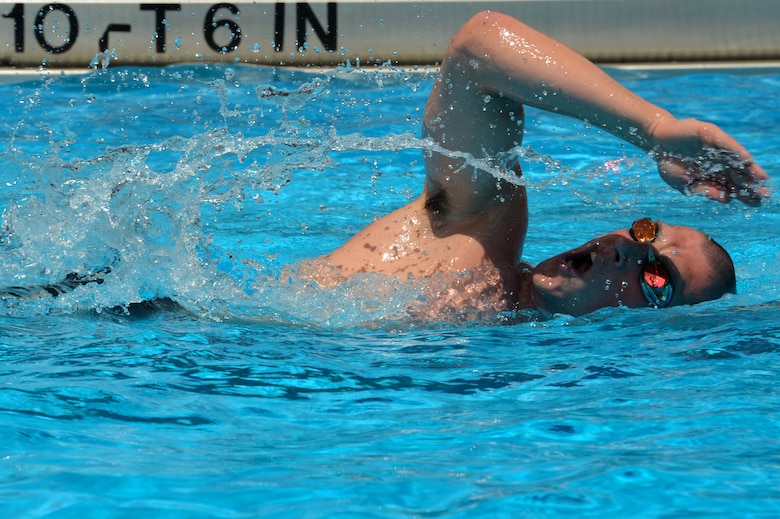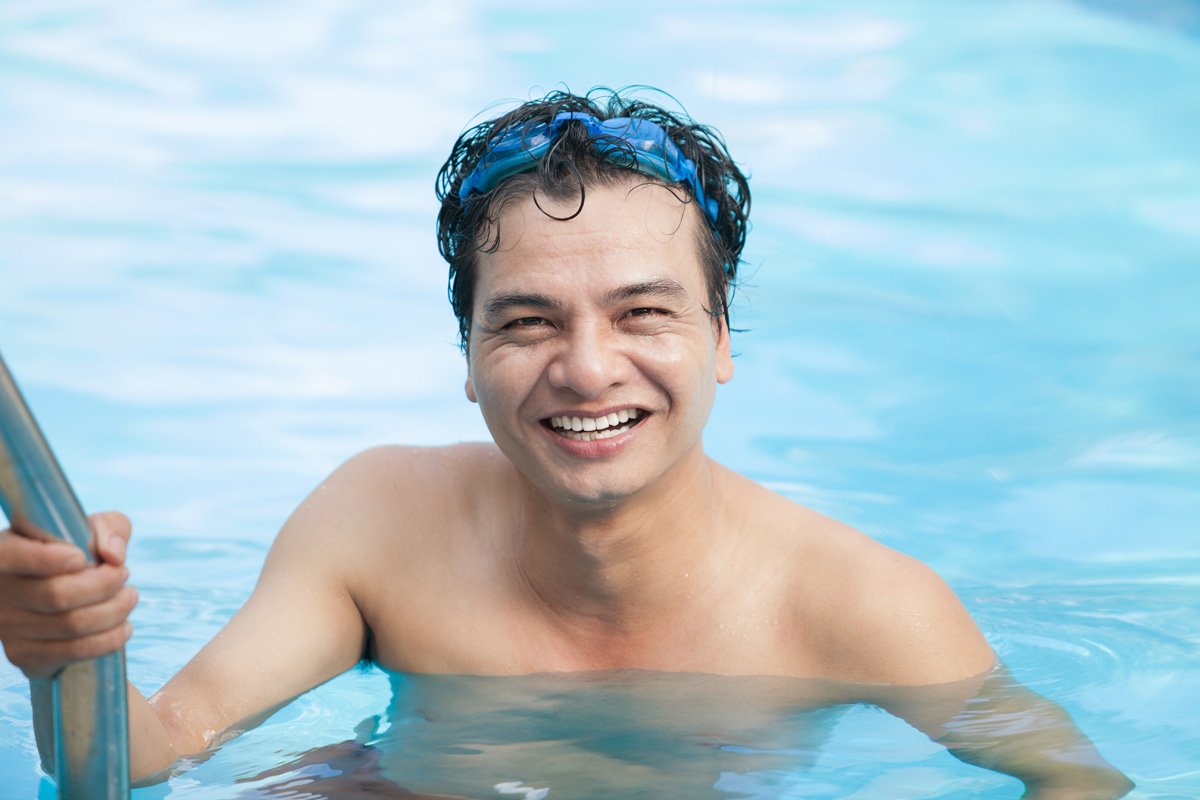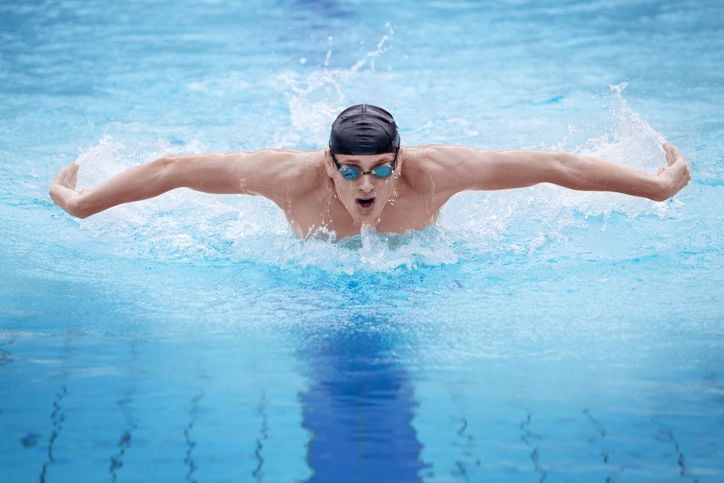
Only 56% of Americans can perform the five core swimming skills, and many adults outside of that 56% of Americans don't know how to swim well. So what does it take to learn to swim as an adult?
Accept that you have a fear of swimming
There's a good chance you've built up a fear of swimming over the years. There's also a good chance you won't realize you are afraid until you make an effort to learn how to swim. You may be scared because of a traumatic experience as a child or perhaps you have an irrational fear of drowning. Whatever the reason, just accept that this fear exists — don't fight it. Once you accept your fear of swimming, and that it is something you can overcome with time and practice, you'll be less likely quit before you accomplish your goal.
Use the proper equipment
 It's important that you have the right equipment available to learn to swim. Goggles are the most important piece of equipment you need. You have to get used to your face being in the water to truly learn how to swim well, and goggles will make it much easier. Pool noodles, swim boards and other flotation devices can also come in handy during your swimming lessons. Our swim instructors usually come prepared with these tools for you to use.
It's important that you have the right equipment available to learn to swim. Goggles are the most important piece of equipment you need. You have to get used to your face being in the water to truly learn how to swim well, and goggles will make it much easier. Pool noodles, swim boards and other flotation devices can also come in handy during your swimming lessons. Our swim instructors usually come prepared with these tools for you to use.
Put your face in the water
This can be the most daunting step in learning how to swim, but it is a necessary step. You have to put your face in the water. Swimming with your face out of the water is highly inefficient unless you're doing the backstroke. The sooner you get more comfortable with your face being in the water, the easier it will be to move forward with your lessons. Although it can be frightening at first, practice will go a long way to easing your fears.
If submersion is uncomfortable for you, try easing yourself into it by using this regular breath exercise. With your feet planted firmly on the bottom of the pool, consciously take a regular breath – not too big and not too small. Maintain pressure behind your nose – you can simulate this at first by puffing out your cheeks if you’re having a hard time. Bend your knees to bring your face (or whole head if you’re comfortable) under the water. Keep your motions controlled and stay calm. You don’t need to stay under for too long. Bring your head up out of the water. Once your feet are flat on the ground, then you can exhale. Maintaining this conscious control of your exhale and stance is important in making sure you’re confident in your breath control. After exhaling, clear your mouth and nose. This might sound gross at first, but it’s common for swimmers to clear their mouth or nose in the pool. Whether this means gently blowing your nose or spitting, it’s ok. Do what you need to do to feel comfortable coming up out of the water.
 Get in the pool as much as possible
Get in the pool as much as possible
If you're serious about learning to swim, it's important that you're in the water as often as you can. As an adult, it can be difficult to find time to get to the pool. If you don't have your own pool, finding one with hours that fit your availability can be difficult. However, if you spend too much time out of the pool between lessons you're likely to regress. The more time you spend in the pool, the sooner you'll be swimming effortlessly.
Sign-up for swimming lessons
 Maybe you've decided to teach yourself how to swim or a friend has offered to teach you. While it's admirable that you're determined to do it on your own, it's ideal for you to sign up for swimming lessons. It's a dangerous and common misconception that teaching yourself how to swim is simple. Swimming is not a natural instinct, and in the case of an emergency, having a professional to assist you is necessary.
Maybe you've decided to teach yourself how to swim or a friend has offered to teach you. While it's admirable that you're determined to do it on your own, it's ideal for you to sign up for swimming lessons. It's a dangerous and common misconception that teaching yourself how to swim is simple. Swimming is not a natural instinct, and in the case of an emergency, having a professional to assist you is necessary.
Beyond happenstance of an emergency, a certified swim instructor can teach you proper techniques and help you overcome whatever fear you may have. Also, lessons guarantee that you're in the pool at least once a week. If you're struggling to find time to get in the pool, signing up for lessons forces you to make the time to work toward your goal.
Practice breathing
Getting your breathing right is one of the things that hampers people from truly mastering swimming. You need to breathe out when you're under the water and breath in when you lift your head out of the water. Proper breathing technique is important when trying to swim across the pool or other distance goals you may want to accomplish. Similar to getting comfortable with putting your face in the water, the more your practice, the easier it will be.
Don't give up
 Look, learning to swim as an adult can be terrifying and embarrassing, but you will feel so proud of yourself once you do master swimming. Don't focus on the fact that you can't do something toddlers can do; the important thing is that you're making an effort to learn. If you keep going, you'll be happily swimming with confidence and proper technique in no time.
Look, learning to swim as an adult can be terrifying and embarrassing, but you will feel so proud of yourself once you do master swimming. Don't focus on the fact that you can't do something toddlers can do; the important thing is that you're making an effort to learn. If you keep going, you'll be happily swimming with confidence and proper technique in no time.
ABOUT SUNSATIONAL SWIM SCHOOL
Sunsational Swim School is the 🥇 #1 rated provider of private, at-home swimming lessons in America. We have specialized swim instructors for students ages 6 months to adult, beginner to advanced. Featured on ABC, CBS, Impact 100, The List and others, Sunsational instructors have a minimum of 2 years of teaching experience, are CPR certified and insured, and have collectively taught over 302,223 lessons for more than 74,415 students nationwide!

